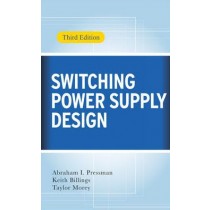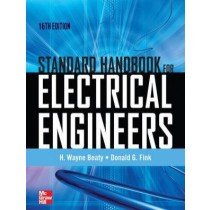Electrical Engineering
-

Switching Power Supply Design 3E
Pages: 880,
Specialty: Electrical Engineering,
Publisher: McGraw-Hill,
Publication Year: 2009,
Cover: Hardback,
Dimensions: 160.02x231.14x48.26mm
The World's #1 Guide to Power Supply Design Now Updated! Recognized worldwide as the definitive guide to power supply design for over 25 years, Switching Power Supply Design has been updated to cover the latest innovations in technology, materials, and components. This Third Edition presents the basic principles of the most commonly used topologies, providing you with the essential information required to design cutting-edge power supplies. Using a tutorial, how-and-why approach, this expert resource is filled with design examples, equations, and charts. The Third Edition of Switching Power Supply Design features: Designs for many of the most useful switching power supply topologies The core principles required to solve day-to-day design problems A strong focus on the essential basics of transformer and magnetics design New to this edition: a full chapter on choke design and optimum drive conditions for modern fast IGBTs Get Everything You Need to Design a Complete Switching Power Supply: Fundamental Switching Regulators * Push-Pull and Forward Converter Topologies * Half- and Full-Bridge Converter Topologies * Flyback Converter Topologies * Current-Mode and Current-Fed Topologies * Miscellaneous Topologies * Transformer and Magnetics Design * High-Frequency Choke Design * Optimum Drive Conditions for Bipolar Power Transistors, MOSFETs, Power Transistors, and IGBTs * Drive Circuits for Magnetic Amplifiers * Postregulators * Turn-on, Turn-off Switching Losses and Low Loss Snubbers * Feedback-Loop Stabilization * Resonant Converter Waveforms * Power Factor and Power Factor Correction * High-Frequency Power Sources for Fluorescent Lamps, and Low-Input-Voltage Regulators for Laptop Computers and Portable Equipment
Weight: 1.27 KG
Learn MoreKWD28.49 -

Standard Handbook for Electrical Engineers 16E
Pages: 2144,
Specialty: Electrical Engineering,
Publisher: McGraw-Hill,
Publication Year: 2012,
Cover: Hardback,
Dimensions: 194x236x68mm
THE MOST COMPLETE AND CURRENT GUIDE TO ELECTRICAL ENGINEERING For more than a century, the Standard Handbook for Electrical Engineers has served as the definitive source for all the pertinent electrical engineering data essential to both engineering students and practicing engineers. It offers comprehensive information on the generation, transmission, distribution, control, operation, and application of electric power. Completely revised throughout to address the latest codes and standards, the 16th Edition of this renowned reference offers new coverage of green technologies such as smart grids, smart meters, renewable energy, and cogeneration plants. Modern computer applications and methods for securing computer network infrastructures that control power grids are also discussed. Featuring hundreds of detailed illustrations and contributions from more than 75 global experts, this state-of-the-art volume is an essential tool for every electrical engineer. Standard Handbook for Electrical Engineers, 16th Edition, covers: Units, symbols, constants, definitions, and conversion factors * Electric and magnetic circuits * Measurements and instruments * Properties of materials * Generation * Prime movers * Alternating-current generators * Direct-current generators * Hydroelectric power generation * Power system components * Alternate sources of power * Electric power system economics * Project economics * Transmission systems * High-voltage direct-current power transmission * Power system operations * Substations * Power distribution * Wiring design for commercial and industrial buildings * Motors and drives * Industrial and commercial applications of electric power * Power electronics * Power quality and reliability * Grounding systems * Computer applications in the electric power industry * Illumination * Lightning and overvoltage protection * Standards in electrotechnology, telecommunications, and information technology
Weight: 3.15 KG
Learn MoreKWD44.99 -

Solid State Electronic Devices, Global Edition, 7e
Pages: 632,
Specialty: Electrical Engineering,
Publisher: Pearson,
Publication Year: 2015,
Cover: Paperback,
Dimensions: 179x231x23mm
For undergraduate electrical engineering students or for practicing engineers and scientists interested in updating their understanding of modern electronics One of the most widely used introductory books on semiconductor materials, physics, devices and technology, Solid State Electronic Devices aims to: 1) develop basic semiconductor physics concepts, so students can better understand current and future devices; and 2) provide a sound understanding of current semiconductor devices and technology, so that their applications to electronic and optoelectronic circuits and systems can be appreciated. Students are brought to a level of understanding that will enable them to read much of the current literature on new devices and applications. Teaching and Learning Experience This program will provide a better teaching and learning experience-for you and your students. It will help: *Provide a Sound Understanding of Current Semiconductor Devices: With this background, students will be able to see how their applications to electronic and optoelectronic circuits and systems are meaningful. *Incorporate the Basics of Semiconductor Materials and Conduction Processes in Solids: Most of the commonly used semiconductor terms and concepts are introduced and related to a broad range of devices. *Develop Basic Semiconductor Physics Concepts: With this background, students will be better able to understand current and future devices.
Weight: 0.91 KG
Learn MoreKWD15.00 -

Soft Computing in Electromagnetics
Pages: 215,
Specialty: Electrical Engineering,
Publisher: Cambridge,
Publication Year: 2016,
Cover: Hardback,
Dimensions: 170x244x18mm
Soft computing techniques are emerging as an important tool in solving design, performance and optimisation problems in electromagnetics. Soft Computing in Electromagnetics offers detailed discussion on the application of soft computing concepts in the field of metamaterial antennas, radar absorbers, transmission line characterisation and optimised radar absorbing material (RAM) and introduces implementation of soft computing tools in a relatively new area of metamaterials. The soft computing methods are used to optimise fault detection, electromagnetic propagation and path loss detection. The development of two CAD packages for design of metamaterial split ring resonators (SRR) and path-loss prediction is discussed. The concepts are explained with the help of algorithms and the corresponding software codes. Numerical examples and MATLAB codes are provided throughout the text to facilitate understanding. show more
Weight: 0.66 KG
Learn MoreKWD17.69 -

Signals, Systems, & Transforms, Global Edition, 5e
Pages: 816,
Specialty: Electrical Engineering,
Publisher: Pearson,
Publication Year: 2014,
Cover: Paperback,
Dimensions: 187.96x231.9x36.07mm
For sophomore/junior-level signals and systems courses in Electrical and Computer Engineering departments. This text provides a clear, comprehensive presentation of both the theory and applications in signals, systems, and transforms. It presents the mathematical background of signals and systems, including the Fourier transform, the Fourier series, the Laplace transform, the discrete-time and the discrete Fourier transforms, and the z-transform. The text integrates MATLAB examples into the presentation of signal and system theory and applications.show more
Weight: 1.27 KG
Learn MoreKWD15.00 -

Signals, Systems and Inference, Global Edition
Pages: 608,
Specialty: Electrical Engineering,
Publisher: Pearson,
Publication Year: 2017,
Cover: Paperback,
Dimensions: 178x232x20mm
For upper-level undergraduate courses in deterministic and stochastic signals and system engineeringAn Integrative Approach to Signals, Systems and InferenceSignals, Systems and Inference is a comprehensive text that builds on introductory courses in time- and frequency-domain analysis of signals and systems, and in probability. Directed primarily to upper-level undergraduates and beginning graduate students in engineering and applied science branches, this new textbook pioneers a novel course of study. Instead of the usual leap from broad introductory subjects to highly specialized advanced subjects, this engaging and inclusive text creates a study track for a transitional course. Properties and representations of deterministic signals and systems are reviewed and elaborated on, including group delay and the structure and behavior of state-space models. The text also introduces and interprets correlation functions and power spectral densities for describing and processing random signals. Application contexts include pulse amplitude modulation, observer-based feedback control, optimum linear filters for minimum mean-square-error estimation, and matched filtering for signal detection. Model-based approaches to inference are emphasized, in particular for state estimation, signal estimation, and signal detection. The text explores ideas, methods and tools common to numerous fields involving signals, systems and inference: signal processing, control, communication, time-series analysis, financial engineering, biomedicine, and many others. Signals, Systems and Inference is a long-awaited and flexible text that can be used for a rigorous course in a broad range of engineering and applied science curricula.show more
Weight: 0.82 KG
Learn MoreKWD15.00 -

Signals Systems and Stochastic Pro
Specialty: Electrical Engineering,
Publisher: Cengage India,
Publication Year: 2017
Weight: 0.6 KG
Learn MoreKWD7.80 -

Signals and Systems: Analysis Using Transform Methods, 3e
Specialty: Electrical Engineering,
Publisher: McGraw-Hill,
Publication Year: 2018,
Cover: Paperback,
Dimensions: 203x254x33mm
Signals and Systems: Analysis Using Transform Methods and MATLAB (R) has been extensively updated, while retaining the emphasis on fundamental applications and theory. The text includes a wealth of exercises, including drill exercises, and more challenging conceptual problems. McGraw-Hill Education's Connect, is also available as an optional, add on item. Connect is the only integrated learning system that empowers students by continuously adapting to deliver precisely what they need, when they need it, how they need it, so that class time is more effective. Connect allows the professor to assign homework, quizzes, and tests easily and automatically grades and records the scores of the student's work. Problems are randomized to prevent sharing of answers an may also have a "multi-step solution" which helps move the students' learning along if they experience difficulty. show more
Weight: 1.39 KG
Learn More -

Signals and Systems: A Primer with MATLAB
Pages: 437,
Specialty: Electrical Engineering,
Publisher: Taylor & Francis,
Publication Year: 2016,
Cover: Hardback,
Dimensions: 156x235x25.4mm
Signals and Systems: A Primer with MATLAB(R) provides clear, interesting, and easy-to-understand coverage of continuous-time and discrete-time signals and systems. Each chapter opens with a historical profile or career talk, followed by an introduction that states the chapter objectives and links the chapter to the previous ones. All principles are presented in a lucid, logical, step-by-step approach. As much as possible, the authors avoid wordiness and detail overload that could hide concepts and impede understanding. In recognition of the requirements by the Accreditation Board for Engineering and Technology (ABET) on integrating computer tools, the use of MATLAB(R) is encouraged in a student-friendly manner. MATLAB is introduced in Appendix B and applied gradually throughout the book. Each illustrative example is immediately followed by a practice problem along with its answer. Students can follow the example step by step to solve the practice problem without flipping pages or looking at the end of the book for answers. These practice problems test students' comprehension and reinforce key concepts before moving on to the next section. Toward the end of each chapter, the authors discuss some application aspects of the concepts covered in the chapter. The material covered in the chapter is applied to at least one or two practical problems or devices. This helps students see how the concepts are applied to real-life situations. In addition, thoroughly worked examples are given liberally at the end of every section. These examples give students a solid grasp of the solutions as well as the confidence to solve similar problems themselves. Some of the problems are solved in two or three ways to facilitate a deeper understanding and comparison of different approaches. Ten review questions in the form of multiple-choice objective items are provided at the end of each chapter with answers. The review questions are intended to cover the "little tricks" that the examples and end-of-chapter problems may not cover. They serve as a self-test device and help students determine chapter mastery. Each chapter also ends with a summary of key points and formulas. Designed for a three-hour semester course on signals and systems, Signals and Systems: A Primer with MATLAB(R) is intended as a textbook for junior-level undergraduate students in electrical and computer engineering. The prerequisites for a course based on this book are knowledge of standard mathematics (including calculus and differential equations) and electric circuit analysis.
Weight: 0.86 KG
Learn MoreKWD17.69 -

Signals and Systems
Specialty: Electrical Engineering,
Publisher: Cengage India,
Publication Year: 2017
Weight: 0.6 KG
Learn MoreKWD7.20



